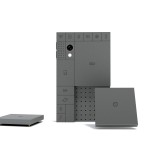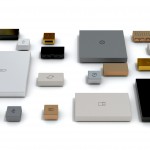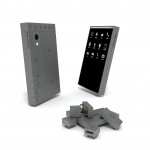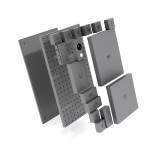by Sundararaja N. Valiyapan | 11 November 2013
The idea behind Phonebloks is pretty simple. It’s a modular smartphone where you can upgrade individual components of the phone, such as camera, processors, RAM, battery, etc. The components or bloks are connected to a base which locks everything together into a solid phone.
Say you want to upgrade your 1GB RAM to a 2GB one, all you need to do is plug out the old blok and plug in the new and voila, your phone now has a 2GB RAM with all the other components intact. You can continue to customize and upgrade your phone to your liking as the bloks break or gets outdated.
- Changing the processing chips (Credits to Phonebloks.com)
- All them ‘bloks’ laid out (Credits to Phonebloks.com)
- A mock up of the product (Credits to Phonebloks.com)
- Bloks specs in your hands (Credits to Phonebloks.com)
- Easy overview of your specs (Credits to Phonebloks.com)
- Playing Lego (Credits to Phonebloks.com)
- Dramatic bloks hovering about! (Credits to Phonebloks.com)
The Brain wave
The man behind phonebloks is Dave Hakkens, a graduate from The Dutch Design Academy, Eindhoven. He hopes to give the world a phone that lasts forever.
It all started when his camera broke. He took it apart to repair it. He found out that all the components were good except the motor — the LCD, the display, the battery, the flash, the gears, everything worked. So, he went online to order the spare part but couldn’t find it. He then had to throw the camera away, along with all the good components.
He says that, “If you have a bike and you get a flat tire, you don’t throw the bike away, you repair the tire. With technology and electronics we don’t do this. We buy it, something breaks, and we throw everything away. I wanted to see if I could change this.”
More than meets the eye
Dave’s vision may sound amazing on paper. However, it is a long way from being a reality. Many engineers and technology experts have voiced concerns over the feasibility of the idea.
For starters, most current smartphones are integrated.
For example, the recent iPhone 5S has its CPU, graphics and RAM clustered into a single processor chip. Breaking this apart into upgradable bloks will make your iPhone consume more power and triple its physical footprint.
This means bulkier phones which drain more power. Not to ignore the fact that Phonebloks would require expensive sockets so that the CPU, graphics, RAM, storage and modem could communicate with one another at a high speed. These are only some of the issues standing in the way of Phonebloks becoming a reality.
Hitting the road: Make believe to reality
To test the public interest in Phonebloks, Dave Hakkens used Thunderclap, a crowdspeaking platform. 979,262 people supported Phonebloks via Thunderclap. The idea had a social reach of a mind boggling 381,772,780 people.
The interest it generated made the mobile phone industry sit up and listen. After a conference with many industry leaders and innovators, Dave Hakkens zoned in on Motorola, a mobile phone maker with a long history in the field and currently owned by Google.
Collaborating with Motorola to develop this idea further gives Phonebloks the best chance to become a reality. While Motorola develops this modular phone idea under the name Project Ara, Phonebloks want to remain an independent organization and help develop the phone platform. This means greater interaction between developers and consumers than ever before in making a product that people want.
Whether the project succeeds or fails doesn’t really matter, it signifies how consumer demands are already shaping the industry. Making sure that these demands are heard and catered to will herald greater innovations and breakthrough in how phones are made.
Visit www.phonebloks.com for more information from the Phonebloks community.
Visit the Official Motorola Blog for more information from Motorola’s Project Ara.
The opinion and views in this article are that of the author and do not reflect the opinion or views of the HKU Journal of Technology, or the TecHKU Editorial Team. You can comment below to let the author know what you think.
To submit an opinion piece of your own, send an email to techkueditors@gmail.com or use the contribute button on the top right of this site.









